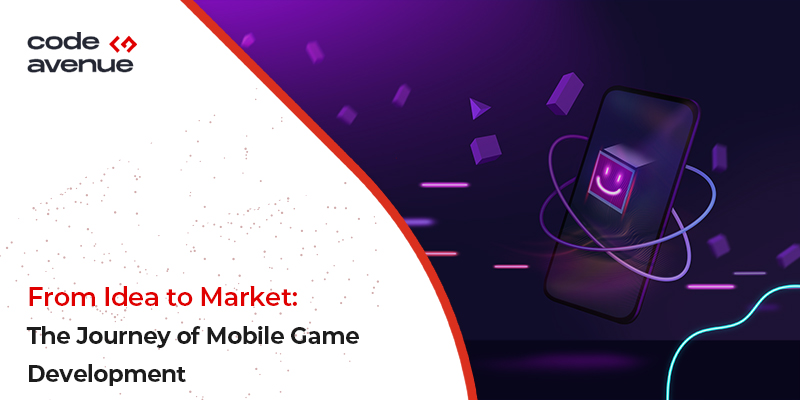Do you ever wonder how those mobile games that are so addictive on your phone come to be? This is the story of a journey in game development for mobiles starting from simple ideas and turning them into interactive experiences played by millions. A better, quicker and more interesting process is guaranteed when working with our top-notch mobile game development company Code-Avenue. Here we shall look at the whole process; right from your idea to when it can hit the market. Come along as we take a thrilling journey through the world of mobile gaming via Code-Avenue!
Understanding the Mobile Game Market
Before embarking on development, it’s important to understand the market. The global mobile gaming industry has exploded with billions of players worldwide today. Games like Candy Crush, PUBG Mobile and Among Us have won over audiences and made big bucks too. Understanding what is happening on the market in terms of trends and favorite genres will help define your game’s concept as well as guarantee its success among players.
Conceptualizing Your Game Idea with Code-Avenue
Every great game starts with a strong idea. At Code-Avenue brainstorming sessions could help generate creative concepts, but also equally important is identifying your target audience, looking at market needs what gaps can this game fill? What kind of unique experiences can you offer? Addressing these questions will provide a solid base for your project.
Creating a Game Design Document (GDD) with Code-Avenue
Your project’s blueprint is called a Game Design Document (GDD). It gives details about what your game is about including its concept, mechanics, story characters etcetera. A good GDD makes sure that everybody in your team knows what they are doing during development process. Some components essential for a GDD include gameplay mechanics level design art style technical specifications among others.
Choosing the Right Development Platform
Picking out an appropriate platform is very crucial. Do you develop for iOS, Android or both? Each platform has its pros and cons. For example, iOS development has a more consistent user base and potentially higher revenue per user while Android has wider reach. Cross-platform development tools like Unity or Unreal Engine can help you target multiple platforms simultaneously.
Selecting the Right Tools and Technologies
The tools you choose can make or break your project. Examples of popular game engines that support 2D and 3D are Unity and Unreal Engine. Swift for iOS programming language, Kotlin for Android and C for cross-platform development are essential skills your team members should have.
Building Your Development Team at Code-Avenue
A successful game requires a talent pool to pull it off Key roles include game designers, developers, artists, testers etc. Finding the right talent may be hard but it’s crucial when bringing out your vision. Code-Avenue is a specialist in putting together experienced teams specifically designed for your project needs.
Prototyping and Early Development
This step is important during the development process because it allows you to test out your core mechanics of the game before going into full production of the game; however, an iterative development approach where small pieces of the game are continuously built upon and tested helps identify problems early on ensuring that by release date there is a polished finished product.
Designing Engaging User Interfaces (UI) and User Experiences (UX)
It is important to note that a good game is not only about fun mechanics but also requires an intuitive and engaging UI/UX. For your game to be easily navigated by players it must have a good UI/UX design and which will improve the overall experience of the player. Designing and prototyping your game’s interface may be done using tools like Adobe XD, Figma, Sketch, etc.
Developing Core Game Mechanics
In any game, its heart lies in its mechanics. These are sets of rules and systems that define how a player interacts with a game world. System building entails coding, testing and enhancing play features to make sure they are enjoyable and attractive. Optimization should remain key hence smooth performance is required.
Integrating Audio and Visual Elements
This is where graphics and sound come into play for creating immersive gaming experiences. High-quality visuals and engaging sound effects can capture players’ interest making them want more of it all time long. This period calls for using Blender when it comes to 3D modeling, Photoshop for rendering purposes while FMOD or wise may work regarding audio integration.
Testing and Quality Assurance
No matter how small or big it is testers must test every game before release. Quality assurance (QA) involves identifying and fixing bugs, ensuring smooth performance, refining gameplay etc. From an individual user perspective alpha-beta testing type may be carried out to collect feedback from real users first few months after launching up until now.
Monetization Strategies
Monetization becomes one of the most important aspects of mobile games development. In-app purchases; ad integration; premium models are among the commonly used strategies to achieve this goal. Taking into consideration one’s target audience coupled with his/her game genre will provide him/her with a clue on which approach he/she would apply. Therefore, as far as game development is concerned, user experience must be balanced with monetization so that players aren’t driven away.
Launching Your Mobile Game with Code-Avenue
The day of launch is a thrilling event accompanied by anxiety. Before the launch there are some marketing strategies which may include social media campaigns, influencer partnerships and press releases to create a buzz about it. Make sure on the launch day that your game can be played via all platforms you targeted, also keep an eye on how it’s going.
Post-Launch Support and Updates
However, after launching the product, this journey is not complete yet. Post-launch support is vital for retaining players and keeping your game relevant. User feedback should be gathered to identify areas of improvement and regular updates should be released to fix bugs and add new content for a better overall experience.
Conclusion
The mobile game development journey is tough but satisfying from inception to market success. Competitive planning combined with appropriate tools and passionate teams such as Code-Avenue will help you come up with a distinctive game that will attract players even if they have many alternatives. Why not begin developing a mobile video game today? Create what you want!
What are some of the expenses that apply to mobile game development?
The cost of development will depend on different factors such as the complexity of a game, the team size and the tools employed. They range from a few thousand dollars for simple games to several hundred thousand or even over to complex ones with good quality.
How do I ensure that my mobile game succeeds?
To make your mobile game successful, concentrate on making it different from others and interesting for players, conduct full market research on user preferences, use successful marketing strategies and offer great post-launch support. You may also ask users for their opinions and frequently upgrade your game to maintain its popularity among players.
What are some common obstacles in developing mobile games?
They include technical problems, maintaining an understandable vision, trying not to be too much creative and practical at once, finding appropriate specialists; keeping within timeframe and budget under control, standing out among competitors in a very tough industry.








